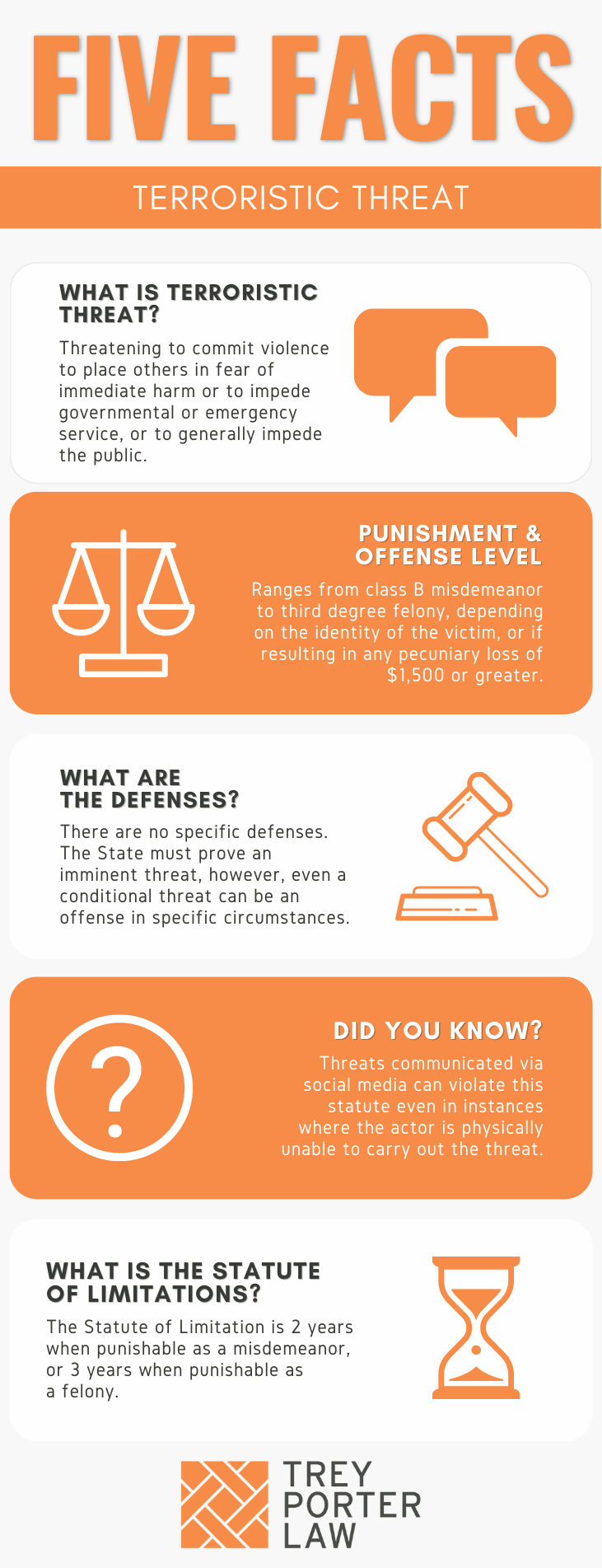WHAT IS TERRORISTIC THREAT IN TEXAS?
The Texas law against terroristic threat prohibits threatening to commit any offense involving violence to another person or property. The punishment severity for this crime depends on the target of the threat, and the reaction sought as a result of the threat.

WHAT IS THE TERRORISTIC THREAT LAW IN TEXAS?
Tex. Penal Code § 22.07. TERRORISTIC THREAT.
(a) A person commits an offense if he threatens to commit any offense involving violence to any person or property with intent to:
(1) cause a reaction of any type to his threat by an official or volunteer agency organized to deal with emergencies;
(2) place any person in fear of imminent serious bodily injury;
(3) prevent or interrupt the occupation or use of a building, room, place of assembly, place to which the public has access, place of employment or occupation, aircraft, automobile, or other form of conveyance, or other public place;
(4) cause impairment or interruption of public communications, public transportation, public water, gas, or power supply or other public service;
(5) place the public or a substantial group of the public in fear of serious bodily injury; or
(6) influence the conduct or activities of a branch or agency of the federal government, the state, or a political subdivision of the state.
(b) An offense under Subsection (a)(1) is a Class B misdemeanor.
(c) An offense under Subsection (a)(2) is a Class B misdemeanor, except that the offense is a Class A misdemeanor if the offense:
(1) is committed against a member of the person’s family or household or otherwise constitutes family violence; or
(2) is committed against a public servant.
(c-1) Notwithstanding Subsection (c)(2), an offense under Subsection (a)(2) is a state jail felony if the offense is committed against a person the actor knows is a peace officer or judge.
(d) An offense under Subsection (a)(3) is a Class A misdemeanor, unless the actor causes pecuniary loss of $1,500 or more to the owner of the building, room, place, or conveyance, in which event the offense is a state jail felony.
(e) An offense under Subsection (a)(4), (a)(5), or (a)(6) is a felony of the third degree.
WHAT IS THE PENALTY CLASS FOR TERRORISTIC THREAT IN TEXAS?
The penalty category for a terroristic threat depends on the target of the threat, and the intended result. Terroristic threat is a:
- Class B misdemeanor, punishable by up to 180 days in county jail, if the person threatens violence with intent to:
- cause a reaction by an official or volunteer agency organized to deal with emergencies; or
- place another in fear of imminent serious bodily injury;
- Class A misdemeanor, punishable by up to one year in county jail, if the person:
- threatens a family or household member, or one with whom the person has or has had a dating relationship, with intent to cause fear of imminent serious bodily injury;
- threatens violence with intent to cause evacuation of a building, aircraft, or other public place;
- State jail felony, punishable by 180 days to two years in a state jail facility, if the person:
- threatens a peace officer or judge;
- threatens violence with intent to cause evacuation of a building, aircraft, or other public place, and causes a monetary loss of $1,500 or more to the owner of the building, room, place, or conveyance;
- Third degree felony, punishable by two to ten years in prison, if the person threatens violence with intent to:
- impair or interrupt a public service;
- place a substantial group of the public in fear of serious bodily injury; or
- influence a governmental body.
WHAT IS THE PUNISHMENT RANGE FOR TERRORISTIC THREAT IN TEXAS?
The punishment range for Class B misdemeanor terroristic threat is up to 180 days in jail, and a maximum $2,000 fine. Class A misdemeanor terroristic threats carry a maximum jail sentence of one year, and up to a $4,000 fine.
State jail felony terroristic threats are punishable by 180 days to two years in a state jail facility, and up to a $10,000 fine. Third degree felony terroristic threats carry a possible two to ten years in prison, and a maximum $10,000 fine.
WHAT ARE THE PENALTIES FOR TERRORISTIC THREAT IN TEXAS?
A person charged with terroristic threat may be eligible for probation after a conviction, or deferred adjudication without a conviction. The maximum term of community supervision for a Class A or Class B misdemeanor terroristic threat is two years. If charged as a state jail felony, the period of supervision may range from two to five years, with the possibility of extending supervision for up to ten years. Community supervision for a third degree felony may not exceed ten years.
WHAT ARE THE DEFENSES TO TERRORISTIC THREAT IN TEXAS?
The statute does not create specific defenses to terroristic threat. In addition to defenses available for all crimes, a person accused of terroristic threat may attempt to negate at least one of the elements the State must prove at trial.
- What does it mean for a terroristic threat of serious bodily to be “imminent”? The Texas Penal Code does not define “imminent,” but Texas appellate courts have interpreted it to mean “near at hand,” “menacing,” and “on the point of happening.” The fact-specific inquiry focuses on whether the accused sought as a desired reaction by his threat to place another in fear of imminent serious bodily injury.One common defense to a terroristic threat charge is that the threat of serious bodily injury was not “imminent.” For example, an accused may assert that the threat was conditional, or depended on the occurrence of something else. But simply because a threat of harm is conditioned upon the occurrence of a future event does not mean the harmful consequences are not imminent.Courts determine whether the victim was afraid of imminent serious bodily injury at the time of the offense, regardless of whether the threat was real, or whether the accused was capable of carrying out the threat.
- What if the victim or target of the threat is not actually placed in fear by the threat? It is not necessary for the victim to actually be placed in fear of imminent serious bodily injury, or for the accused to have the capability or the intention to actually carry out the threat. A person may be convicted of terroristic threat if, by his or her threat, he or she sought to place another in fear of imminent serious bodily injury.
WHAT IS THE STATUTE OF LIMITATIONS FOR TERRORISTIC THREAT IN TEXAS?
The limitation period for terroristic threat classified as a misdemeanor is two years. For third degree and state jail felony terroristic threats, the limitation period is three years.
TERRORISTIC THREAT IN TEXAS
In Texas, it is a crime to threaten a person or property with violence. If committed against a family or household member, or a public servant, the offense is punishable as a Class A misdemeanor. When a violent threat is directed at a group of people, a governmental body, a peace officer or judge, or the threat interrupts a public service, the offense becomes a felony. While the First Amendment protects most forms of speech and expression, it does not extend to true threats of violent, unlawful acts.
TEXAS TERRORISTIC THREAT COURT CASES
The case law regarding terroristic threat in Texas shows appellate courts defer to law enforcement’s assessment of the seriousness of a threat in most cases.
- In Phillips v. State, a man called 911 several times demanding that an officer come to his home. He told 911 operators not to send Officer Steve Christian, and if that officer showed up, he would “blow his brains out.” The defendant was charged with coercion of a public servant, retaliation, and making a terroristic threat to influence a governmental body. The jury found him guilty.The appellate court affirmed the conviction, explaining that it is unnecessary for the victim to actually be in fear or imminent serious bodily injury, or for the defendant to have the capability or intention to actually carry out the threat.
- Social media posts may also be terroristic threats. In Garcia v. State, defendant was convicted of making a terroristic threat with intent to cause a reaction by an agency organized to deal with emergencies. He posted on Facebook that he would “personally go around and see how many police officials [he] can kill.”The appellate court affirmed the conviction because the First Amendment does not protect “true threats,” including an express intent “to commit an act of unlawful violence to a particular individual or group of individuals, regardless of whether the speaker actually intends to carry out the threat.”
- In Williams v. State, a mother threatened a teacher at her son’s school. She told the teacher she would take her to the parking lot for “a beat down,” and she would “whip” her if she ever spoke to her child again. The teacher said she feared for her safety.The appellate court determined it was not necessary for the victim to actually be placed in fear of imminent serious bodily injury or for the accused to have had the capability or the intention to actually carry out the threat. It is enough if the accused intended to place another in fear of imminent serious bodily injury.
















